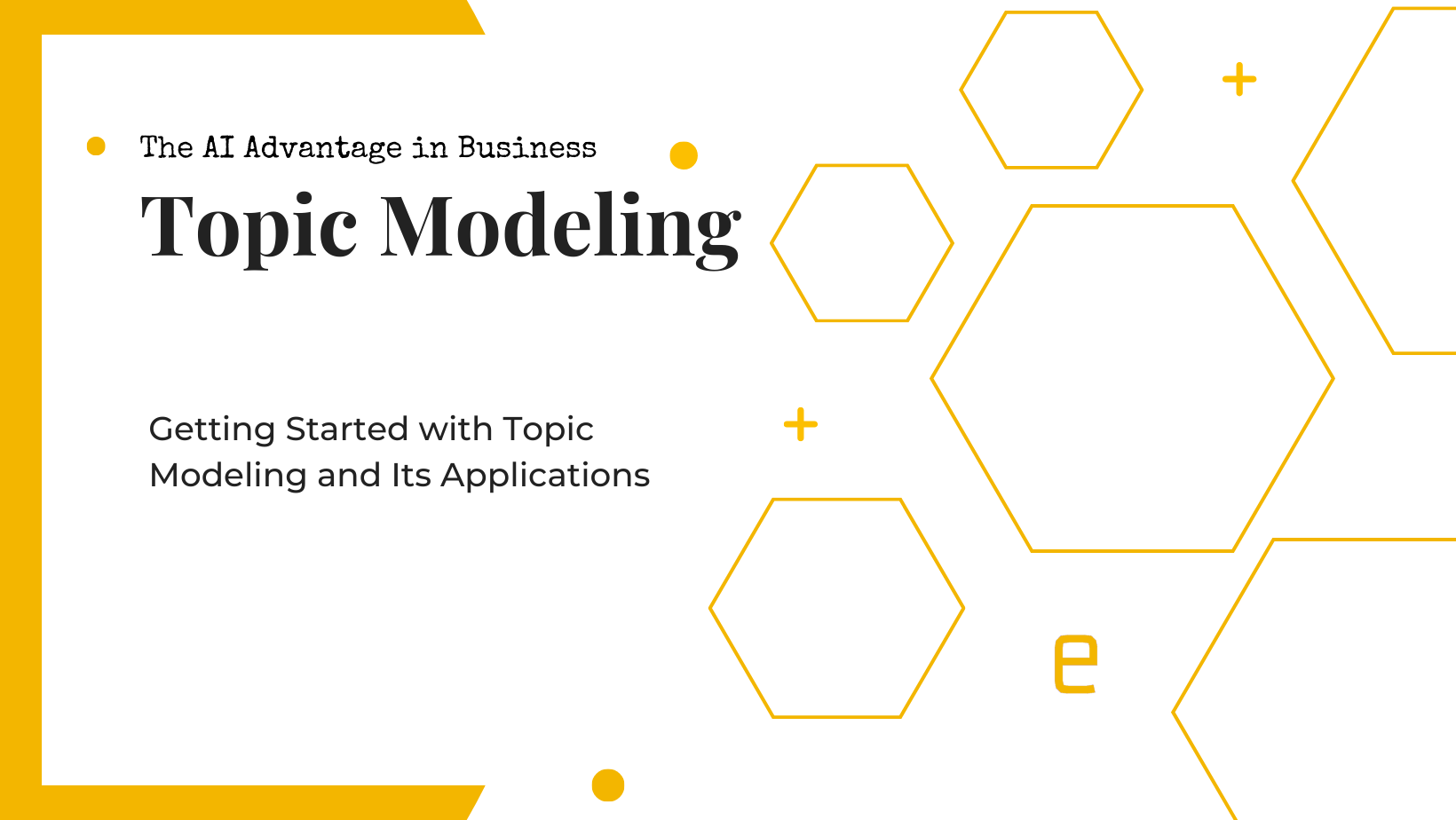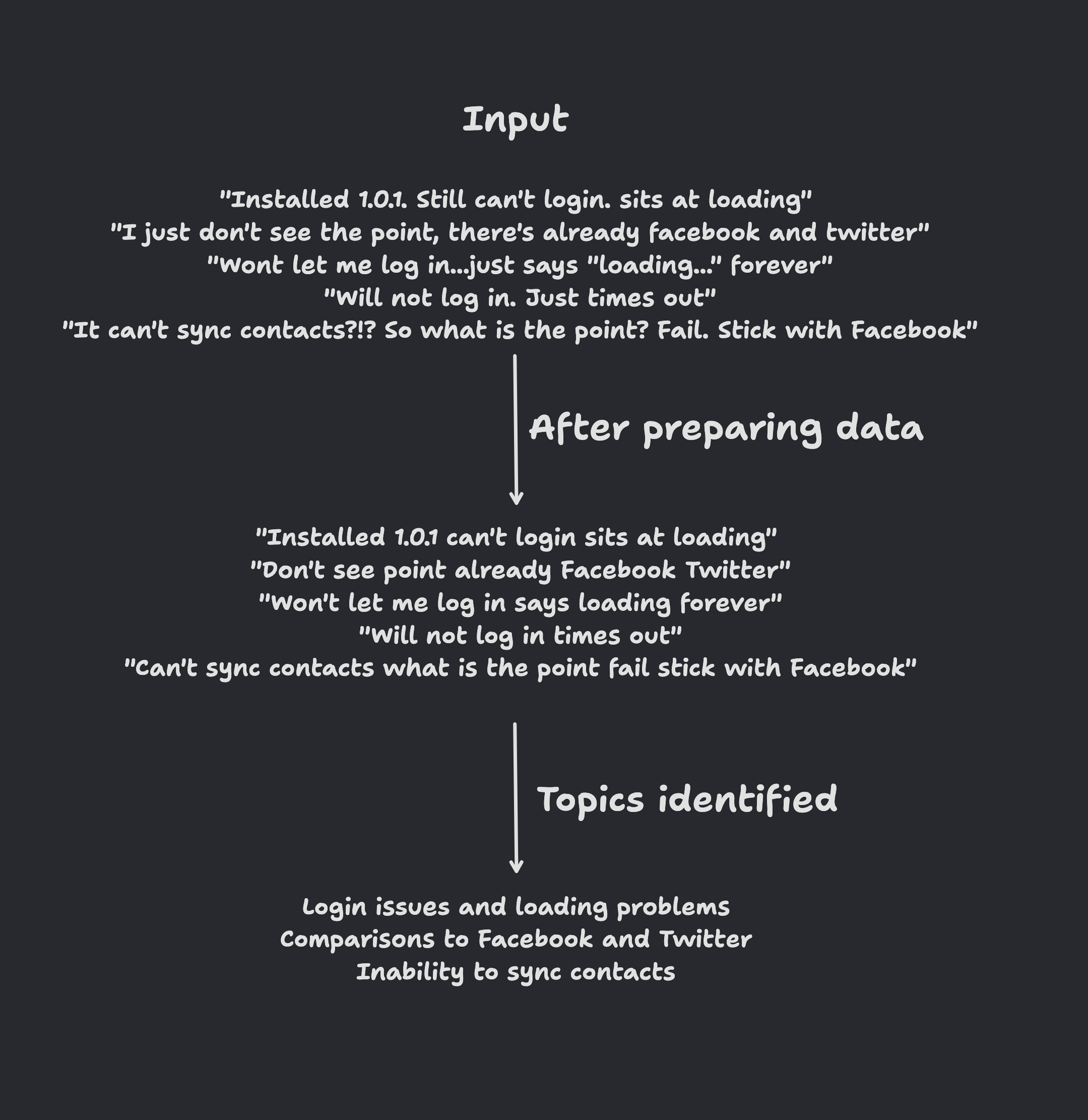Getting Started with Topic Modeling and Its Applications
 Sugandha Kapoor
Sugandha KapoorTable of contents
- Unlocking the Secrets of Data to Gain a Competitive Edge with Topic Modelings
- Decoding Topic Modeling: Methods and Steps
- Traditional Topic Modeling Techniques vs. GPT-4
- Transforming Business with Topic Modeling: Real-World Applications
- Case Study: Implementing Cohesive Strategies with Topic Modeling
- Conclusion

Unlocking the Secrets of Data to Gain a Competitive Edge with Topic Modelings
Finding meaningful insights in the maze of big data is like searching for a needle in a haystack. That's where Topic Modeling steps in, guiding businesses to the insights that matter and transforming their approach to data analysis.
Topic modeling is a powerful Natural Language Processing (NLP) technique to identify key themes or topics within large text datasets.
In a digital world, where large volumes of data are generated daily, topic modeling has become an essential tool for businesses to make sense of large volumes of information.
The adoption of topic modeling can transform how companies approach data analysis. It can help businesses understand the underlying themes in customer feedback, social media chatter, or market research.
Understanding these hidden patterns in data is crucial for businesses to make informed decisions and build cohesive strategies to gain a competitive edge.
Topic modeling streamlines data analysis and helps businesses use insights from their data effectively, improving sales and customer engagement.
But how does this work in practice? Let’s explore how businesses across various sectors are applying topic modeling to unlock the potential of their data.
Decoding Topic Modeling: Methods and Steps
To get a better understanding of how topic modeling works behind the scenes, let's review the steps involved in it:
Preparing the data: This first step is about getting the text data ready. It includes cleaning the data by taking out stopwords, punctuation, and special characters. This step is important to make sure the data is ready for analysis.
Vectorization: After preparing the data, the text is transformed into a numerical format using popular vectorization methods like Bag of Words or TF-IDF. More advanced topic modeling often employs word embeddings, which provide a deeper understanding of linguistic contexts for more accurate topic detection. These complex vector embeddings are effectively managed in vector databases like emno. These databases are designed for handling large vector data sets and help significantly improve the speed and accuracy of the topic modeling process.
Use Topic Modeling Algorithms: Finally, we use a topic modeling algorithm to find latent topics. Latent Dirichlet Allocation (LDA), Non-Negative Matrix Factorization (NMF), and Latent Semantic Analysis (LSA) are popular techniques used for this. We will not be going into the details of these techniques here as they are outside the scope of this blog.
As an example, applying topic modeling to the given customer feedback might result in the following topics:

Traditional Topic Modeling Techniques vs. GPT-4
While traditional techniques like LDA are specifically designed for topic modeling, GPT-4, as an advanced language model, offers a broader range of NLP capabilities. Although not used for topic modeling in the conventional sense, GPT-4 can complement these traditional methods by providing enhanced language understanding and supporting various NLP tasks related to text analysis.
The traditional models for topic modeling are more scalable and accurate; however, they can be computationally demanding, especially for large datasets. GPT-4 can process and analyze large datasets at an unprecedented scale and speed in some cases.
Also, these traditional methods might sometimes struggle with producing semantically coherent topics, particularly with very diverse or complex datasets. GPT-4's advanced language understanding capabilities allow it to generate more coherent and contextually relevant topics, making it a powerful tool for extracting insights from text.
Data privacy is another key consideration for handling any company's data. Companies can execute traditional methods locally for sensitive data without needing cloud-based processing, as in the case of GPT-4.
Eventually, the choice of topic modeling technique depends on the task's specific needs, the dataset's nature, computational resources, and concerns about interpretability and data privacy.
With these basics in place, let's now explore how businesses leverage topic modeling to transform their data into actionable business insights.
Transforming Business with Topic Modeling: Real-World Applications
In today's data-driven digital landscape, any information gathered from customers, whether implicit, such as engagement, or explicit, like feedback and reviews, is a crucial resource for businesses. Using this information well can make a big difference in a competitive market.
Topic modeling, when combined with other NLP techniques such as summarization, sentiment analysis, and data analysis, can offer deeper insights and a more comprehensive view of feedback or market trends.
With these techniques, companies can better understand not just the dominant trends but also the sentiments and overall narratives connected to them. This enables businesses to adapt to customer needs and market changes rapidly.
Improving Content Strategy in Media
Media companies like the New York Times can use topic modeling to identify what content their audience likes. Using topic modeling and other NLP techniques, they can analyze their past articles, competitors' articles, reader comments, and engagement on these articles.
For example, they might observe a growing interest in topics like 'renewable energy' or 'zero-waste lifestyles.' With this information, the New York Times can create more content about these subjects and include these topics and related words in their SEO and marketing strategies.
This focused approach helps attract a targeted audience, increase readership, and boost ad revenue by keeping up with current trends and reader interests.
Incorporating Customer Feedback in Product and Marketing
Understanding customer needs is crucial for survival and growth for businesses at any stage, from startups to established companies.
Take the example of a retail giant like Walmart. They utilize topic modeling to sift through customer reviews and social media feedback. This analysis helps them identify trends in shopping preferences and product demands. By adjusting their inventory and marketing strategies based on these insights, Walmart continues to cater effectively to its customer base.
Similarly, a startup like Blue Apron uses topic modeling to gain insights into customer dietary trends and preferences. This helps them refine their meal kit offerings and service features.
In another example, a tech startup could use topic modeling to understand user reviews and engagement with their app or software. The information they get can help them make targeted improvements, prioritize new features, and help the business grow.
By deploying topic modeling, companies at any stage can distill customer conversations into actionable insights, shaping strategies that resonate with their market. In the next section, we will dive deeper into the practical applications of this technology across different business contexts.
Enhancing Personalized Recommendations
In e-commerce and content platforms, topic modeling greatly enhances recommendation algorithms by analyzing and categorizing content into distinct topics.
Platforms such as Medium utilize this technique to offer personalized article recommendations to new users, efficiently overcoming the 'cold start' problem.
Techniques like content-based and collaborative filtering are instrumental in this process of personalizing content. To learn more about how these filtering methods work, read our blog post on 'Recommendation Systems 101: Content & Collaborative Filtering Methods.' Understanding these techniques helps us better understand how topic modeling helps align user preferences with content, significantly improving the user experience.
Improving Product Categorization and Sorting in E-commerce
In another application of topic modeling in retail, companies like Amazon, Walmart, and Target use advanced data analysis techniques like topic modeling to enhance their product categorization. By analyzing product descriptions, customer reviews, and search patterns, topic modeling helps in automatically sorting products into relevant categories such as 'electronics,' 'home goods,' or 'fashion.' This greatly improves the online shopping experience for customers and helps improve inventory management and targeted marketing strategies.
Summarizing...
So, topic modeling in business isn't just for analyzing data; it's about turning data into actionable strategies. By using this technology well, companies can understand their customers better and improve their internal processes and content strategies.
This leads to more informed decision-making, enhanced customer engagement, and, ultimately, sustained business growth in a digitally-driven world.
Case Study: Implementing Cohesive Strategies with Topic Modeling
Our company, GadgetPro, makes and sells electronic gadgets. We recently launched a new smartwatch, the 'GadgetPro SmartTime,' and received thousands of online reviews on various platforms.
These reviews are invaluable to our marketing and product teams in refining their strategies:
Our marketing team aims to fine-tune marketing strategies, improve brand messaging, and effectively reach potential customers.
Our product team seeks to learn from these reviews to update our product and address customer needs.
To assist both teams, we employ topic modeling. Here's how we do it:
Gathering Insights
Collecting and Preparing Data
At GadgetPro, we gather all SmartTime smartwatch reviews from Amazon, Best Buy, and social media platforms.
Sample Customer Reviews
"Love the battery life on my SmartTime, lasts all day!"
"Frustrated with the SmartTime app, keeps crashing on my phone."
"The design of SmartTime is sleek and comfortable to wear."
"Had issues syncing SmartTime with other devices."
"SmartTime's fitness tracking features are really accurate and useful."
"The user interface of the SmartTime could be more intuitive."
"Battery drains too quickly on my SmartTime, needs improvement."
"Enjoying the wide range of apps compatible with SmartTime."
"The screen resolution on SmartTime is amazing, very clear!"
"Connectivity issues with SmartTime, often loses Bluetooth connection."
Topic Extraction
Our data science team extracts key topics from these reviews, identifying prevalent themes.
Topics Identified
Battery Life
App Performance
Design and Comfort
Fitness Tracking Accuracy
Connectivity and Syncing Issues
Enhancing Insights with NLP and Data Analysis
We apply additional NLP techniques like sentiment analysis, frequency analysis, and text summarization to deepen our understanding of this data. We apply sentiment analysis to understand the emotional tone behind each topic and frequency analysis to gauge how often each topic is mentioned. Text summarization provides us with concise overviews of the reviews.
With this, we have more enhanced data, as seen in this table.
| Topic | Overall Sentiment | Frequency (in % of reviews that mention this) | Summary |
| Battery Life | Mixed | 40% | Customers appreciate the long-lasting battery, though some report quick drainage. |
| App Performance | Negative | 30% | Repeated mentions of app crashes and compatibility issues with phones. |
| Design and Comfort | Positive | 20% | Users find the SmartTime sleek and comfortable, often praising its aesthetic. |
| Fitness Tracking Accuracy | Positive | 10% | High satisfaction with the accuracy of fitness features. |
| Connectivity and Syncing Issues | Negative | 25% | Frustrations with Bluetooth connectivity and device syncing problems. |
Incorporating Quantitative Data Analysis
We use quantitative data analysis to validate and augment our data. This includes examining customer data such as preferences, demographics, geographic locations, operating systems, etc. In addition to this, we conduct a thorough analysis of market trends and competitor strategies to understand the bigger picture.
This detailed approach helps us identify our target audience and their specific preferences. It also helps us understand key market trends and how our competitors address similar challenges.
This comprehensive analysis is crucial for our marketing and product teams to have a holistic view of customer feedback and current market dynamics. It enables them to make informed decisions and ensures our strategies are competitive and innovative.
With this rich, data-backed understanding in hand, let's see how these insights directly inform and shape our strategic decisions in marketing and product development.
Working with the Insights
The results of the analysis now help us shape our business strategies. Here are some examples:
Marketing Strategy
Highlighting Positive Features
We focus on showcasing SmartTime's positively reviewed features in our marketing campaigns, such as fitness tracking accuracy, design, and comfort.
We also highlight these positive testimonials on our website to build trust and credibility.
Addressing Negative Feedback
- We actively communicate recent improvements in app stability and connectivity issues through our digital ads, email updates, and other channels, reassuring both potential and existing customers of our commitment to product excellence.
Improving Content Strategy
- We create engaging blog posts, videos, and social media content around topics that resonate with our customers, like "Maximizing Your SmartTime Battery Life" and "Getting the Most Out of Your SmartTime Fitness Tracking."
Segmenting Customers and Running Tailored Campaigns
We design targeted campaigns to appeal to specific customer segments based on their interests, behavior, or demographics. For instance:
For health and fitness enthusiasts, we run a social media campaign highlighting how SmartTime assists in achieving fitness goals.
For users with concerns about connectivity, we run email campaigns or in-app notifications that emphasize the recent enhancements in connectivity and syncing features.
Competitive Analysis
- We regularly analyze how SmartTime's features stack up against competitors' products. For instance, we emphasize superior design comfort and fitness tracking in our marketing materials, capitalizing on the positive feedback in these areas.
Influencer Partnerships
- We partner with fitness and tech influencers to leverage their audience base, focusing on SmartTime's positively reviewed fitness tracking features.
Sample Marketing Campaign - Putting it into Action:
Given the positive reception of SmartTime's 'Fitness Tracking Accuracy,' we launch a marketing campaign titled 'Elevate Your Fitness Game with SmartTime.' This campaign includes targeted social media ads, partnerships with fitness influencers, and a series of blog posts and videos showcasing SmartTime's role in enhancing fitness routines. This strategic approach, driven by our topic modeling insights, specifically targets fitness enthusiasts, strengthening our market presence in the fitness tech sector.
Product Strategy
Feedback for Product Development
- We focus on improving app performance and connectivity in the next updates, addressing the concerns of 30% and 25% of reviewers, respectively.
Handling Negative Feedback
- We collaborate with the marketing team to prepare communication strategies addressing the battery life, app, and connectivity issues, including public responses or FAQs.
Monitoring and Adapting
Monitoring Impact
- We closely monitor the impact of these strategies on sales and customer engagement, paying special attention to the areas with the most negative feedback (app performance and connectivity issues).
Ongoing Analysis
- We continuously analyze new reviews and market trends, adapting our strategies to align with evolving customer needs and preferences.
Why This Approach Works
Data-driven: Our decisions are based on comprehensive data analysis, aligning closely with customer feedback and market trends. This increases our chances of getting it right.
Adaptive: Regular review and adjustment of our strategies ensure they remain effective in meeting customer needs and we can respond swiftly to evolving market trends.
Enhanced Engagement: We aim to increase customer satisfaction and revenue by improving product quality and marketing effectiveness.
This case study illustrates how topic modeling, combined with NLP and data analysis, guides our product improvements and marketing tactics, fostering a cohesive and informed approach to our business strategy.
Conclusion
Topic modeling is an important tool for businesses today because it transforms vast text data into actionable insights. It helps companies understand what customers want and follow market trends, laying the foundation for cohesive strategies and agility in a dynamic landscape.
As AI continues to evolve, topic modeling will integrate with new technologies to give even deeper insights and more creative uses. We might soon have models that can predict future customer actions and shifts in market trends. Such innovations will further empower businesses to stay ahead of the curve, giving them tools to keep growing and adapting in the ever-changing digital world.
Subscribe to my newsletter
Read articles from Sugandha Kapoor directly inside your inbox. Subscribe to the newsletter, and don't miss out.
Written by

Sugandha Kapoor
Sugandha Kapoor
Founder | Product Manager | Builder